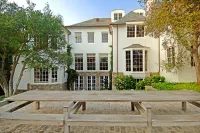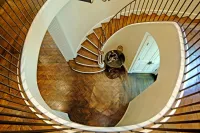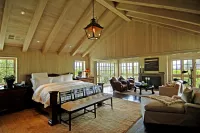Share what you know,
and discover more.
Share what you know,
and discover more.
Mar 04, 2022
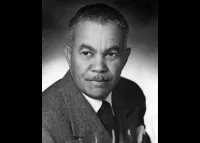
-

- Dave D
PAUL REVERE WILLIAMS, FAIA (1894-1980)
Williams was born in Los Angeles CA to parents who moved from Memphis TN. Williams was two years old when his father died and four when his mother died. Williams and his brother were placed in separate foster homes. Williams was the only Black child in his elementary school. At Polytechnic High School a teacher advised him against pursuing a career in architecture because white clients would not want a Black architect - and there were not enough Black clients who could afford an architect. He persevered and worked for Wilbur Cook, Reginald Johnson, Arthur Kelly, and John C. Austin. He became the first Black graduate from USC in 1919. He was appointed to the LA Planning commission in 1920 and was licensed as a California architect in 1921. Williams opened his own practice on the side in 1922 and became the first Black member of the national AIA in 1923. In 1933, he became an associate of the DC-based Hilyard Robinson firm and was licensed to practice in NY and DC. In 1941, after the Pearl Harbor attack by the Japanese in Hawaii, Williams decided to close his LA office and work solo. From 1939-1940, architect A. Quincy Jones worked for Williams and the two collaborated on at least 20 projects after 1942, including the 1947 Palm Springs Tennis Club. Willliams' groovy La Concha Motel in Las Vegas NV became The Neon Museum. His books were The Small Home of Tomorrow (1945) and New Homes for Today (1946). He is author of the famous essay "I am a Negro" published in the 1937 American Magazine and reprinted in Ebony in 1986. He was one of the very few prominent Black Republicans in California. He was advisor to the 1948 movie, Mr. Blanding Builds His Dream House, the first time a real house is built for a movie set. He received an honorary degree from Howard University in 1952; another from Tuskegee in 1957; and the Springarn Medal from the NAACP in 1953. He appeared on the TV show This Is Your Life in 1953. In 1962, Williams designed the St. Jude Children's Hospital in Memphis TN for his friend Danny Thomas. In 1957, Williams was the first Black architect named a Fellow by the AIA. He retired in 1973 and was given the national AIA Gold Medal in 2017. His business records were mostly destroyed during the April 1992 LA riots but his drawings survived, kept by granddaughter Karen Hudson for decades, and given to USC and the Getty in 2020.
PAUL REVERE WILLIAMS, FAIA (1894-1980)
Williams was born in Los Angeles CA to parents who moved from Memphis TN. Williams was two years old when his father died and four when his mother died. Williams and his brother were placed in separate foster homes. Williams was the only Black child in his elementary school. At Polytechnic High School a teacher advised him against pursuing a career in architecture because white clients would not want a Black architect - and there were not enough Black clients who could afford an architect. He persevered and worked for Wilbur Cook, Reginald Johnson, Arthur Kelly, and John C. Austin. He became the first Black graduate from USC in 1919. He was appointed to the LA Planning commission in 1920 and was licensed as a California architect in 1921. Williams opened his own practice on the side in 1922 and became the first Black member of the national AIA in 1923. In 1933, he became an associate of the DC-based Hilyard Robinson firm and was licensed to practice in NY and DC. In 1941, after the Pearl Harbor attack by the Japanese in Hawaii, Williams decided to close his LA office and work solo. From 1939-1940, architect A. Quincy Jones worked for Williams and the two collaborated on at least 20 projects after 1942, including the 1947 Palm Springs Tennis Club. Willliams' groovy La Concha Motel in Las Vegas NV became The Neon Museum. His books were The Small Home of Tomorrow (1945) and New Homes for Today (1946). He is author of the famous essay "I am a Negro" published in the 1937 American Magazine and reprinted in Ebony in 1986. He was one of the very few prominent Black Republicans in California. He was advisor to the 1948 movie, Mr. Blanding Builds His Dream House, the first time a real house is built for a movie set. He received an honorary degree from Howard University in 1952; another from Tuskegee in 1957; and the Springarn Medal from the NAACP in 1953. He appeared on the TV show This Is Your Life in 1953. In 1962, Williams designed the St. Jude Children's Hospital in Memphis TN for his friend Danny Thomas. In 1957, Williams was the first Black architect named a Fellow by the AIA. He retired in 1973 and was given the national AIA Gold Medal in 2017. His business records were mostly destroyed during the April 1992 LA riots but his drawings survived, kept by granddaughter Karen Hudson for decades, and given to USC and the Getty in 2020.
Mar 04, 2022
PAUL REVERE WILLIAMS, FAIA (1894-1980)
Williams was born in Los Angeles CA to parents who moved from Memphis TN. Williams was two years old when his father died and four when his mother died. Williams and his brother were placed in separate foster homes. Williams was the only Black child in his elementary school. At Polytechnic High School a teacher advised him against pursuing a career in architecture because white clients would not want a Black architect - and there were not enough Black clients who could afford an architect. He persevered and worked for Wilbur Cook, Reginald Johnson, Arthur Kelly, and John C. Austin. He became the first Black graduate from USC in 1919. He was appointed to the LA Planning commission in 1920 and was licensed as a California architect in 1921. Williams opened his own practice on the side in 1922 and became the first Black member of the national AIA in 1923.In 1933, he became an associate of the DC-based Hilyard Robinson firm and was licensed to practice in NY and DC. In 1941, after the Pearl Harbor attack by the Japanese in Hawaii, Williams decided to close his LA office and work solo. From 1939-1940, architect A. Quincy Jones worked for Williams and the two collaborated on at least 20 projects after 1942, including the 1947 Palm Springs Tennis Club. Willliams' groovy La Concha Motel in Las Vegas NV became The Neon Museum. His books were The Small Home of Tomorrow (1945) and New Homes for Today (1946). He is author of the famous essay "I am a Negro" published in the 1937 American Magazine and reprinted in Ebony in 1986. He was one of the very few prominent Black Republicans in California. He was advisor to the 1948 movie, Mr. Blanding Builds His Dream House, the first time a real house is built for a movie set. He received an honorary degree from Howard University in 1952; another from Tuskegee in 1957; and the Springarn Medal from the NAACP in 1953. He appeared on the TV show This Is Your Life in 1953. In 1962, Williams designed the St. Jude Children's Hospital in Memphis TN for his friend Danny Thomas. In 1957, Williams was the first Black architect named a Fellow by the AIA. He retired in 1973 and was given the national AIA Gold Medal in 2017. His business records were mostly destroyed during the April 1992 LA riots but his drawings survived, kept by granddaughter Karen Hudson for decades, and given to USC and the Getty in 2020.
Posted Date
Mar 08, 2022
Historical Record Date
Mar 04, 2022
Source Name
US Modernist
Source Website
Delete Story
Are you sure you want to delete this story?
Mar 02, 2022
Mar 02, 2022
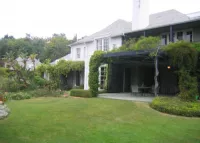
-

- Dave D
Castera-Ward Residence
Designed by architect Paul Revere Williams in 1936, this Bel-Air residence is a rare and remarkably intact example of his residential work in concrete, as well as an important local example of French Provincial architecture. It was also the longtime home of actress Jane Wyatt, who donated the home to the California Community Foundation before her death in October 2006.
Castera-Ward Residence
Designed by architect Paul Revere Williams in 1936, this Bel-Air residence is a rare and remarkably intact example of his residential work in concrete, as well as an important local example of French Provincial architecture. It was also the longtime home of actress Jane Wyatt, who donated the home to the California Community Foundation before her death in October 2006.
Castera-Ward Residence
Designed by architect Paul Revere Williams in 1936, this Bel-Air residence is a rare and remarkably intact example of his residential work in concrete, as well as an important local example of French Provincial architecture.It was also the longtime home of actress Jane Wyatt, who donated the home to the California Community Foundation before her death in October 2006.
Posted Date
Mar 08, 2022
Historical Record Date
Mar 02, 2022
Source Name
Los Angeles Conservancy
Delete Story
Are you sure you want to delete this story?


